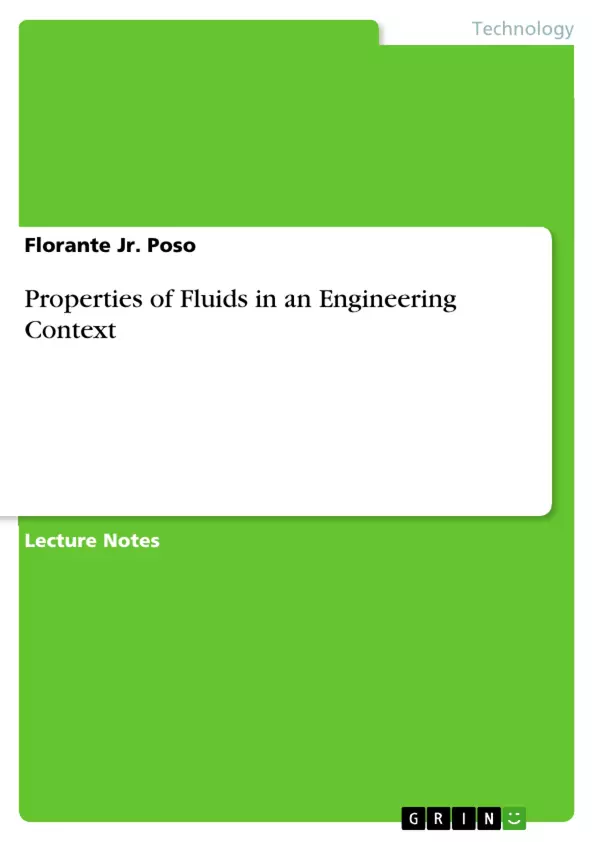This script discusses the different properties of fluids. In a general context, fluids are classified as either a liquid or gases, although in other textbooks, it also incorporates plasma as part of its scope. The coverage of this script is limited to the detail discussion of the fluid properties such as the density, viscosity, compressibility and elasticity, vapor pressure, surface tension and capillary rise or depression. Specific problems are presented with detailed solutions to guide the reader on the step by step procedure of solving in an engineering point of view.
The study of fluid mechanics is utilized in the field of engineering most specifically on engineering structures that incorporates the conveyance of fluids in the system. Pipelines and machines like turbines and engines also use the principles of fluid mechanics. Thus, it is cognizant to learn the basics of the properties of fluids in order to have a better grasp of the principles of fluids in application to engineering works. The units that were used in the illustrations are all in metric system.
Table of Contents
- Introduction
- Properties of Fluids
- Density
- Mass Density
- Specific Weight
- Relative Density
- Viscosity
- Compressibility and Elasticity
- Vapor Pressure
- Surface Tension
- Capillary Rise / Depression
- Conclusion
- References
Objectives and Key Themes
The objective of this eBook is to provide a detailed discussion of the properties of fluids, specifically focusing on density, viscosity, compressibility, elasticity, vapor pressure, surface tension, and capillary rise or depression. The text aims to enhance understanding of these properties within an engineering context, offering solved problems to guide readers through practical applications.
- Fluid Properties and their definitions
- Application of fluid properties in engineering
- Problem-solving techniques in fluid mechanics
- Calculations involving density, specific weight, and relative density
- Understanding of concepts like viscosity, compressibility, and surface tension
Chapter Summaries
Introduction: This introductory chapter establishes the scope of the eBook, which is limited to a detailed examination of several key fluid properties: density, viscosity, compressibility and elasticity, vapor pressure, surface tension, and capillary rise or depression. The chapter emphasizes the practical application of fluid mechanics in engineering, particularly in the design and operation of systems involving fluid conveyance, like pipelines and machinery such as turbines and engines. The use of the metric system throughout the text is also noted. The importance of understanding fundamental fluid properties for successful engineering application is highlighted.
Properties of Fluids: This chapter delves into the various properties of fluids. It begins with a definition of density and proceeds to explain mass density, providing a formula (ρ = m/V) and a worked example to calculate the mass density of oil. The concept of specific weight (γ = ρg) is then introduced, with calculations demonstrating how to determine the specific weight of both water and air. The chapter concludes by defining relative density (the ratio of a substance's density to that of water), emphasizing its unitless nature and its common use in comparing the densities of different liquids.
Keywords
Fluid mechanics, fluid properties, density, mass density, specific weight, relative density, viscosity, compressibility, elasticity, vapor pressure, surface tension, capillary rise, engineering applications, problem-solving.
Frequently Asked Questions: A Comprehensive Guide to Fluid Properties
What is the main topic of this eBook?
This eBook provides a detailed discussion of the properties of fluids, specifically focusing on density, viscosity, compressibility, elasticity, vapor pressure, surface tension, and capillary rise or depression. It emphasizes practical applications within an engineering context.
What are the key themes explored in the eBook?
The key themes include fluid properties and their definitions, the application of fluid properties in engineering, problem-solving techniques in fluid mechanics, and calculations involving density, specific weight, and relative density. Understanding concepts like viscosity, compressibility, and surface tension is also central.
What topics are covered in the "Properties of Fluids" chapter?
This chapter defines and explains density, mass density (with a formula and example calculation), specific weight (with example calculations for water and air), and relative density. It emphasizes the unitless nature of relative density and its use in comparing liquid densities.
What is the purpose of the introductory chapter?
The introduction sets the scope of the eBook, highlighting the focus on key fluid properties and their practical application in engineering, particularly in systems involving fluid conveyance (pipelines) and machinery (turbines, engines). It also notes the use of the metric system.
What types of problems are addressed in the eBook?
The eBook includes solved problems to guide readers through practical applications of fluid mechanics, focusing on calculations involving density, specific weight, and relative density.
What are the key terms or keywords associated with this eBook?
Key words include: Fluid mechanics, fluid properties, density, mass density, specific weight, relative density, viscosity, compressibility, elasticity, vapor pressure, surface tension, capillary rise, engineering applications, and problem-solving.
What is the overall structure of the eBook?
The eBook includes an introduction, a chapter on the properties of fluids (covering density, specific weight, relative density, viscosity, compressibility, elasticity, vapor pressure, surface tension, and capillary rise/depression), a conclusion, and a list of references.
What is the target audience for this eBook?
The target audience is likely engineering students or professionals who need a comprehensive understanding of fluid properties and their applications in engineering design and problem-solving.
Where can I find a Table of Contents?
The table of contents includes: Introduction, Properties of Fluids (with sub-sections on Density, Mass Density, Specific Weight, Relative Density, Viscosity, Compressibility and Elasticity, Vapor Pressure, Surface Tension, and Capillary Rise/Depression), Conclusion, and References.
- Arbeit zitieren
- Florante Jr. Poso (Autor:in), 2015, Properties of Fluids in an Engineering Context, München, GRIN Verlag, https://www.grin.com/document/441517



